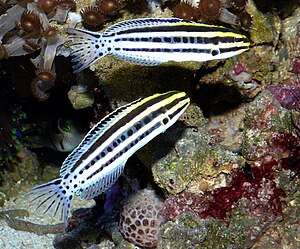Three-lined saber-toothed mucus
| Three-lined saber-toothed mucus | ||||||||||||
|---|---|---|---|---|---|---|---|---|---|---|---|---|

Three-lined saber-toothed mucus ( Meiacanthus grammistes ) |
||||||||||||
| Systematics | ||||||||||||
|
||||||||||||
| Scientific name | ||||||||||||
| Meiacanthus grammistes | ||||||||||||
| ( Valenciennes , 1836) |
The three-lined saber-toothed mucus ( Meiacanthus grammistes ) occurs in the western, tropical Pacific from the coast of Vietnam to New Guinea , north to the Ryūkyū Islands and south to the Great Barrier Reef . It lives there both in protected lagoons and in outer reefs and is relatively common. On the coasts of southern Japan it is being replaced by Meiacanthus kamoharai .
features
The fish becomes a maximum of eleven centimeters long. It is of a yellow and white basic color, more yellow in front, more white in the back. Three long black longitudinal bands run along its flanks, another is formed by a row of dots in the long, continuous dorsal fin . This is supported by four hard rays and 25 to 28 soft rays, with the anal fin there are two hard rays and 14 to 16 soft rays. The dissolution of the black horizontal stripes on the tail fin stalk into a dot pattern distinguishes the three-stripe saber-toothed mucus from very similar species, such as Meiacanthus lineatus .
Toxicity
Like all saber-toothed mucous fish, the three-lined saber-toothed mucous fish has very elongated canine teeth in the lower jaw which, like all meiacanthus species, are provided with poison glands at the base. When pressure is exerted by a bite, the poison is injected into the wound through a groove on the front of the tooth. The poison is used for defense and contains opioids that cause sedation in the attacker . The conspicuous warning color is supposed to prevent predators from attacking. Predatory fish spit Meiacanthus TYPES immediately after being bitten by them in the mouth again. In humans, the bite causes pain like a wasp sting , as well as sweats and dizziness. The two poison teeth are replaced by reserve teeth behind them if they are lost. The shape and color of the three-lined saber-toothed mucous fish is imitated by the non-toxic saber-toothed mucous fish species Petroscirtes breviceps and the cardinal perch Cheilodipterus zonatus ( Bates' mimicry ).
Way of life
The three-lined saber-toothed mucous fish is, in contrast to the algae-eating crest-toothed mucous fish that constantly sit down on various observation posts, a "free swimmer" that forms schools near coral reefs and feeds on zooplankton .
Reproduction
During courtship, the male places all of its fins and gill covers wide apart in front of the female. His yellow-colored skin areas glow intensely. After impressing the male several times, the female follows him into the brood cavity and lays around 300 eggs there, each with a diameter of less than one millimeter. The eggs are then fertilized by the male. The male spawns in the following five to seven days with three to four others or the first female. The larvae hatch after about five days some time after sunset. They are then about 3.5 mm long, have no yolk sac and have to eat immediately.
literature
- Hans A. Baensch / Robert A. Patzner: Mergus Sea Water Atlas Volume 7 Perciformes (perch-like) , Mergus-Verlag, Melle, 1998, ISBN 3-88244-107-0
- Ewald Lieske, Robert F. Myers: Coral fish of the world . 1994, year publisher, ISBN 3-86132-112-2
- Matthias Bergbauer, Robert Myers, Manuela Kirschner: The cosmos handbook dangerous marine animals. Kosmos Stuttgart, 2008, ISBN 978-3-440-10945-8
- Andre Luty: Saber-toothed slimy fish, the blennids of the open water. Pages 16 to 20 in Der MeerwasserAquarianer, specialist magazine for seawater aquaristics, 3/2008, Rüdiger Latka Verlag, ISSN 1432-1505
Individual evidence
- ↑ Casewell et al .: The Evolution of Fangs, Venom, and Mimicry Systems in Blenny Fishes. Current Biology, 2017, DOI: 10.1016 / j.cub.2017.02.067
Web links
- Three-striped saber-toothed mucus on Fishbase.org (English)